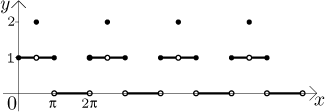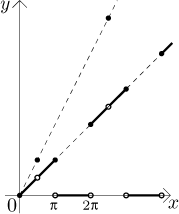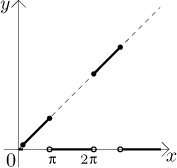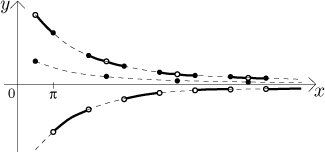Here we will explore closer some interesting situations with oscillation. It
is assumed that the reader already checked on the
previous problem. We will skip
complete and formal proofs as we prefer to develop intuition here. Formal
proofs would be similar to those in the previous problem, either proving in
the positive using comparison or disproving using Heine's theorem.
Problem: Evaluate (if it exists)

Solution:
We already investigated the behaviour of the expression
x(1 + sin(x)) in the previous problem, so we know that it
oscillates between 0 and 2x as we approach infinity with x. It
is also always positive or zero, so
1 + x(1 + sin(x)) is at least 1
and oscillates between 1 and 1 + 2x. Consequently, when we put it into a
denominator of a fraction with 1 on the top, this fraction will oscillate
between 1 and 1/(1 + 2x). Since the latter tends to zero at infinity,
for really large values of x the given expression oscillates between 1
and "almost 0", our guess therefore is that the limit does not exist. To
prove it we would consider sequences
xn = π/2 + 2nπ and
yn = 3π/2 + 2nπ.
The situation looks roughly like this:

Note: We had to put "1 +" in the denominator, since the expression
x(1 + sin(x)) is zero at infinitely many points going to infinity.
Therefore there is no neighborhood of infinity where the resulting fraction
would exist, hence limit there would not make sense.
This is not a problem in the following expression.
Problem: Evaluate (if it exists)

Solution: The sine oscillates between −1 and 1, so
2 + sin(x)
oscillates between 1 and 3 included. Thus
x(2 + sin(x))
oscillates between x and 3x, in particular it goes to
infinity. Consequently, 1 over this expression goes to zero. How would we
prove it? If an expression with a bounded oscillation goes to zero, the
absolute value version of the
Squeeze theorem seems best. At
infinity we have

By the way, once we understand how 2 + sin(x) behaves, we can easily
guess that

does not exists (the fraction oscillates between 1 and 1/3) and that

Here we would use one-sided comparison, we can estimate the given expression
from below by x/3 to push it up.
Problem: Evaluate (if it exists)

Solution: The expression 1 + sin(x) oscillates between 0 and 2
included, so when we apply the function
integer part to it, we will
get constant parts with values 0, 1 and 2.

When we multiply this by x, we get oblique segments that lie on the
lines y = 0,
y = x, and
y = 2x.

Thus the limit does not exist.
By the way, what can we say about the expression
Int(0.9 + 0.9sin(x))?
The expression 0.9 + 0.9sin(x) oscillates
between 0 and 1.8 included,
so when we apply the integer part to it, we get segments at levels 0 and 1.
Thus there are two differences compared to the previous example. The first
difference is that the expression has only two values, we got rid of the
one-point dots at level 2 above that might cause troubles. One possible
application is to use this in the expression
1/2 − Int(0.9 + 0.9sin(x)),
which now has two distinct values, −1/2 and 1/2.
The second difference is that now the segments at level 0 are longer than the
segments at level 1, unlike the previous example, where the picture was
nicely regular.
Finally, the expression
x⋅Int(0.9 + 0.9sin(x)) gives
segments that lie in turn on the line
y = x and
y = 0.

Thus the limit of this expression at infinity does not exist.
Problem: Evaluate (if it exists)

Solution:
We know that Int(1 + sin(x)) is a function that consists of segments at
levels 0, 1, and 2 (there are just dots there). When we subtract
1/2, we get a
function whose graph is segments at levels −1/2,
1/2, and 3/2. Thus the
function
x[Int(1 + sin(x)) − 1/2] has a graph that consists of
segments that lie on lines y = −x/2,
y = x/2, and
y = 3x/2.
Since the graph keeps jumping between lines that go to infinity and a line
that goes to negative infinity, it follows that it does not have any limit at
infinity. What do we get when we divide 1 by this expression? The given
expression is sometimes equal to −2/x, sometimes
2/x and
sometimes 2/(3x). All three curves tend to zero at infinity, so any
function that jumps between these three graphs also has to tend to zero.

How would we prove it? Since we have an oscillating expression with bounded
parts, we would guess that
comparison can help. Since we want
to prove that something goes to zero, the absolute value version of the
Squeeze theorem seems best.

Next problem
Back to Solved Problems - Limits
![]()

![]()
![]()
![]()
![]()
![]()



![]()

